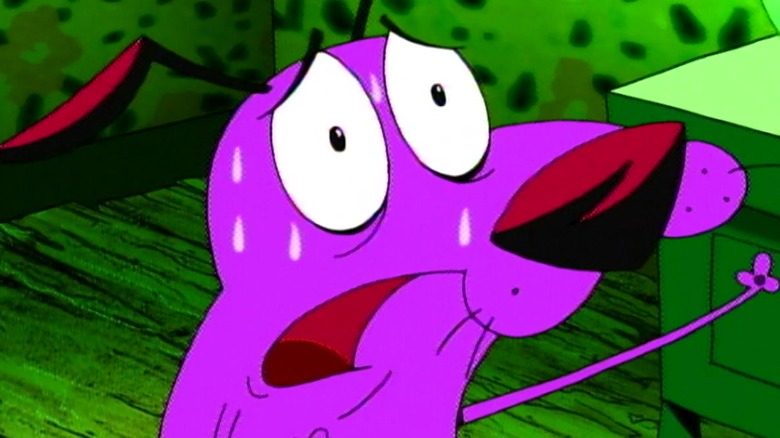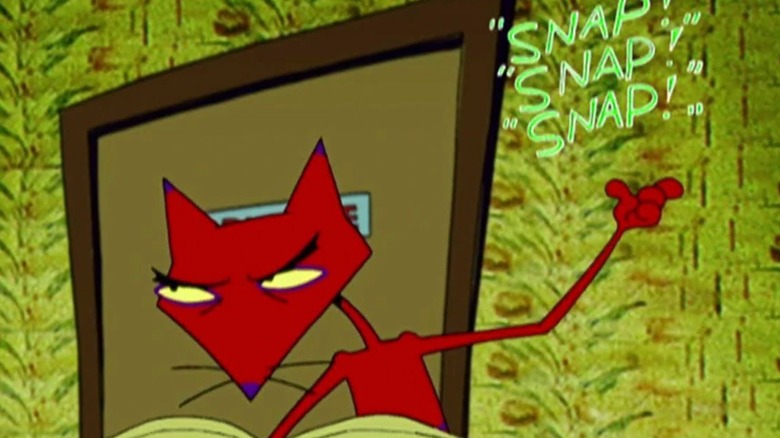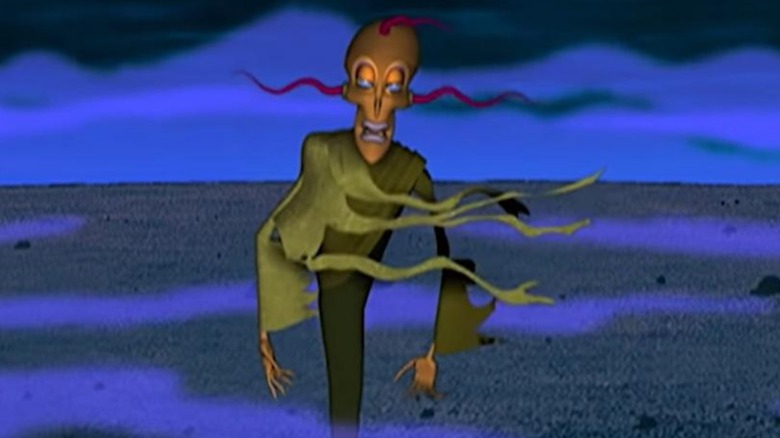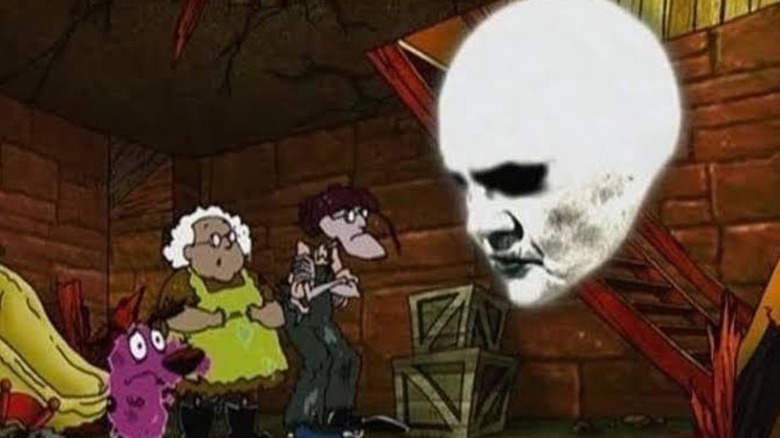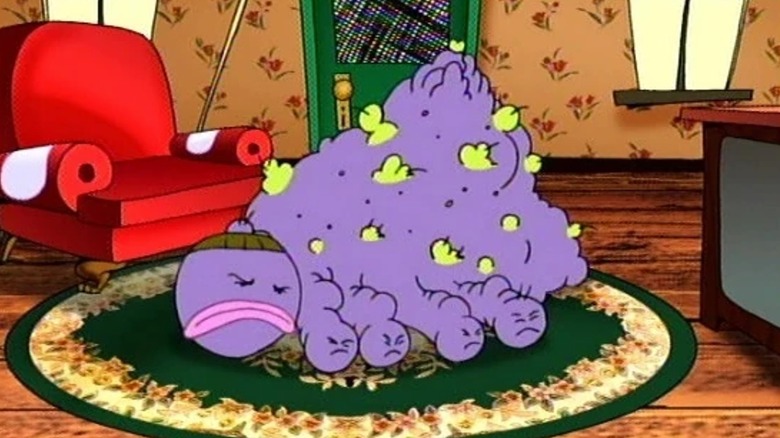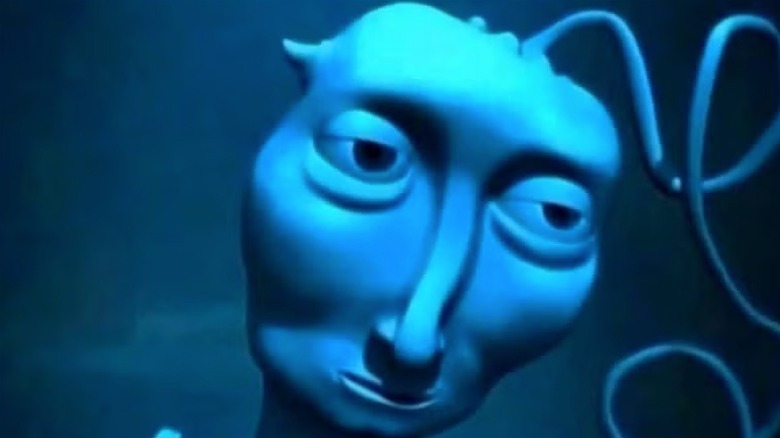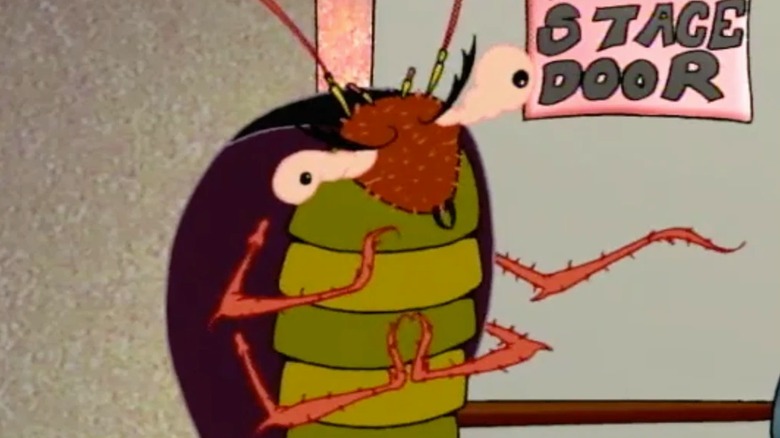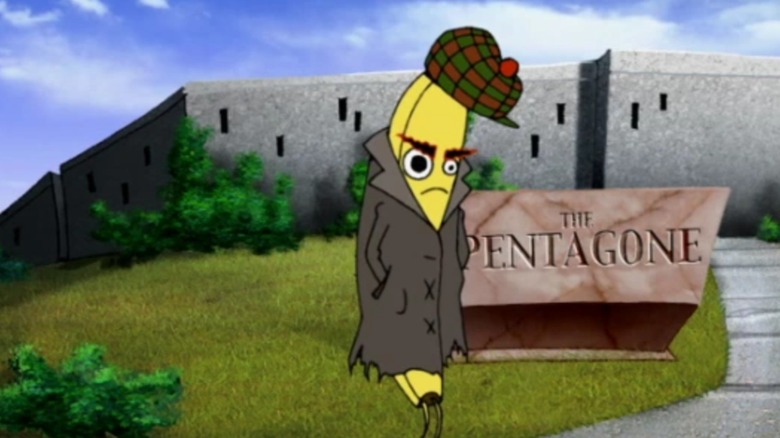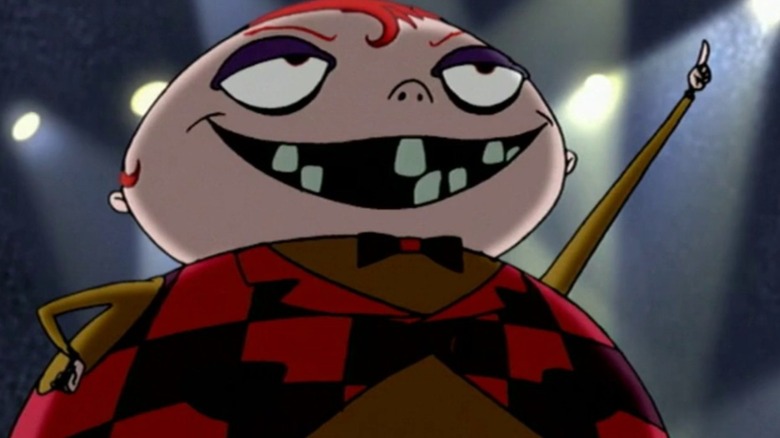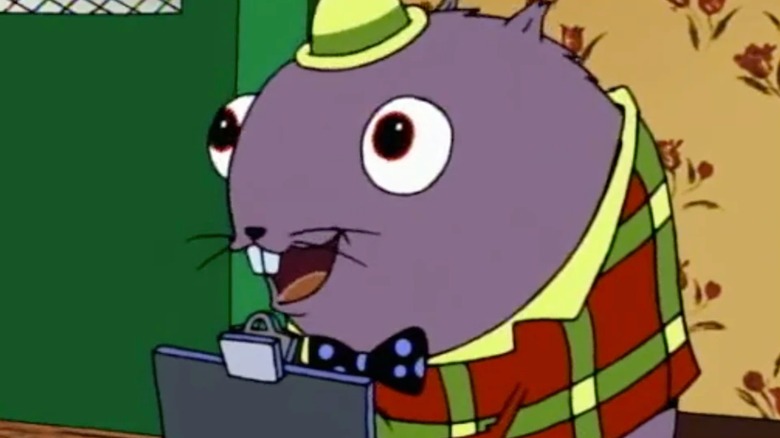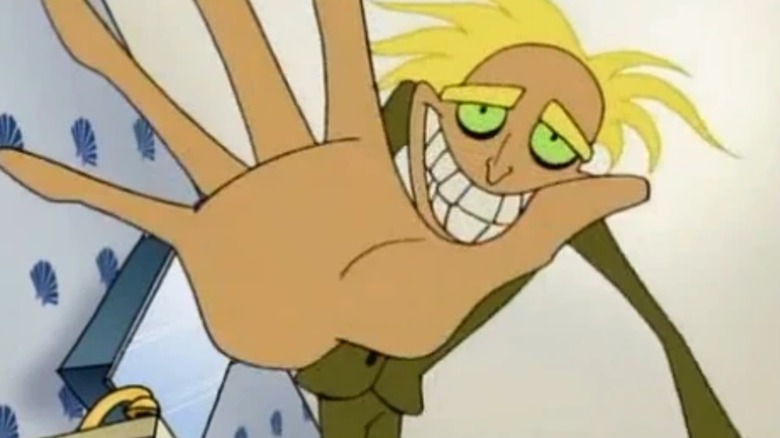10 Worst Villains In Courage The Cowardly Dog
From the eerie backrooms-on-steroids saga of Kane Pixels' "The Oldest View" and the viral curse-themed analog horror of "The Boiled One" to the late stage capitalist brain rot of Nutter Butter's traumatizing TikTok commercials, surrealist horror seems to be in its golden age these days thanks to the internet. But long before entire generations were mass-consuming creepypasta instead of after-school cartoons, millennial kids could get a crash course in horror tropes with Cartoon Network's superficially innocuous nightmare fuel "Courage the Cowardly Dog," as its titular pink fraidy-beagle (voiced by Howard Hoffman and Marty Grabstein) throws down with a steady stream of childhood trauma-inducing villains.
With a main character like Eustace Bagge (Howard Hoffman/Lionel Wilson/Arthur Anderson/Wallace Shawn/Jeff Bergman), the sadistic husband of Courage's beloved primary owner Muriel (Thea White), the bar for malevolence is already set pretty high. After all, it's hard to beat someone who gives his wife a gnarly case of hydrocephalus, chops down a sentient giving tree out of petty jealousy, and at one point, quite literally refuses to help a little old lady cross the street. But in the adventures of Courage, even Eustace seems tame next to some of the scheming, nefarious, and downright freaky creeps that inhabit Nowhere, Kansas.
In a world where time-traveling meteors and mass hypnosis are very real threats, Courage constantly face off with some of the most phobia-unlocking villains ever to appear in a children's program. Oh, the things he does for love.
Katz
Like Darth Vader and Khan Noonien Singh before him, Katz (Paul Schoeffler) is a villain so bold he rolls with his own theme song — and it's a bop. A feline entrepreneur who apparently got his business degree in the bad place, Katz is Courage's longest-running foe, first appearing in "A Night at Katz Motel." With a svelte red physique and the buttery-smooth voice of Higgins from "Magnum, P.I.," he's as charismatic as he is conniving. But Katz is more trickster than con man. He isn't in it for the money but the pure pleasure of callously heaping misery upon others.
Courage first meets Katz when he, Eustace, and Muriel stumble upon the one-star Katz Motel while on a road trip. After banishing Courage to the outdoors for the same persecution endured by another famous cartoon beagle in "Peanuts," Katz takes to menacing all three guests with his beloved army of Katz spiders before engaging Courage in a high-stakes game of racquetball.
Although the trio manage to thwart Katz's shenanigans each time, the sinister feline resurfaces again frequently, usually with a new business model. There's the Katzian answer to the White Lotus in "Klub Katz," where guests are transformed into machinery before getting pitted against each other gladiator-style for Katz's amusement. In "Katz Kandy," he uses his candy store to create a jam monster and kidnap Muriel for her secret recipe. But no matter what he's up to, Katz's sociopathic cruelty is entirely the point.
King Ramses
The horror powering King Ramses (John R. Dilworth) of "King Ramses' Curse" begins with his uncanny appearance. Unlike most characters in the series, Ramses is animated using CGI from the dawn of the millennium. Juxtaposed against the colorful traditional animation of "Courage," Ramses looks like nightmare fuel ripped from a Y2K-era PC computer game.
Ramses first appears after Courage and Eustance come into possession of a stone slab unearthed by grave robbers. Tempted by the possibility of its value, Eustace clings to it even after the spirit of Ramses shows up to demands its return with his haunting imperative, "Return the slab!" As Ramses looms in the distance eerily repeating his curse, surrounded by creepy blue fog with his gray-green wrappings floating around him, the Pharaoh's odd, unnatural movements and strange CGI appearance infuse the episode with an almost David Lynchian energy.
As one Reddit user put it, "The entire character was a thing of nightmares. The different style of animation made you notice whenever he appeared on screen ... Ramses was scary because he was just different enough from everything else to be unsettling." The fact that the second of his three plagues is an intolerably catchy underworld earworm is nothing short of diabolical. If this iconic cartoon ever gets the reboot it badly deserves, a Ramses reprisal should be a priority.
The Spirit of the Harvest Moon
The only possible explanation for the Spirit of the Harvest Moon is that the creators of "Courage the Cowardly Dog" felt the unnerving CGI of Ramses hadn't gone far enough in traumatizing an entire generation of children. A large, bald, white floating head with black, sunken eyes and all the charm of a paralysis demon, the Spirit of the Harvest Moon (Peter Fernandez) appeared in "The House of Discontent" to harangue the Bagges and threaten them with eviction from their property on the charge that they don't respect their land.
With its high-contrast black and white, the spirit's monochromatic face has the surreal quality of photographic negatives. Even when the Spirit isn't doling out anything beyond vague threats, his black lips and eyes create a sense of low-grade horror as he demands a higher standard of environmentalism from Eustace. The accompanying haunted house organ music, the Spirit's haunting, echoing voice, and the accusatory tone he uses to condemn Eustace add to the disturbingly dark children's horror that forever scarred many viewers.
And terrify the children he certainly did. "King Ramses was a threat, make no mistake, but the Harvest Moon Ghost? Nightmare nightmare nightmare," wrote one Redditor. Another added, "I remember the 1st time I watched this with my sister. When this guy talked she just ran out the living room and I just stayed."
Foot fungus
It's hard to say what makes the foot fungus gangsters in the "Courage the Cowardly Dog" episode "The Clutching Foot" collectively one of the best worst villains in the series. The creatures literally emerge from Eustace's foot after he wakes up with it severely itchy, purple, and green, eventually swelling to the size of a living room rug and engulfing him. If that wasn't bad enough, each toe grows a face that comes with an old-timey gangster accent to match. The big one even comes with a brown toenail that doubles as a thick head of auburn "hair."
With the big toe (Paul Schoeffler) acting as mob boss, the foot fungus crew sets to work carrying out a series of robberies by taking Muriel hostage and using Courage to do their dirty footwork. After their bank and train robberies go south, they set their sights on ripping off all of Florida except, for some reason, Boca Raton. In his desperation, Courage uploads a fungus sample to the computer, who tells him dog saliva is the only cure.
What follows is one of the most gag-worthy moments in the series, as Courage licks the foot fungus until Eustace's foot is shrunk back to normal. The fungus' willingness to take on all of Florida might not be the worst crime in "Courage," but the way they absorb Eustace for most of the story arc is pretty unsettling.
Bugle Monster
If by some miracle Ramses and the Spirit of the Harvest Moon managed to escape a child's nightmares, there's little chance the Bugle Monster (John R. Dilworth) seen in "Perfect" would, with its heady blend of surrealistic and existential horror. The drama begins — relatably enough — with a disappointing package delivery. After Eustace has a bugle delivered, he realizes it won't play correctly because it got damaged in transit somehow. At the same time, Courage — suffering from low self-esteem likely as a result of Eustace's constant berating — is plagued by visions of an abusive schoolmarm called The Perfectionist (Gerrianne Raphael), who demands he learn to speak and act perfectly or suffer lifelong humiliation.
Later as he is drifting off to sleep, Courage imagines a blue fetal being with a strange, distorted adult face, claymation-like features, and an umbilical cord — a manifestation of Eustace's broken trumpet. "You're not perfect," the blue creature tells him in a quiet, masculine adult voice while floating dreamily in the blue amniotic fluid. With its too-soothing voice and CGI style reminiscent of stop-motion claymation, the Bugle Monster calls to mind Satan from the 1985 stop-motion film "The Adventures of Mark Twain."
It's one of the darkest moments in an already dark animated show, which is why it's so satisfying to see this episode end on a wholesome note when a fish tells Courage there's no such thing as perfect and he's beautiful the way he is.
Schwick
Anytime you're traveling to a major city, it's important to avoid getting taken in by unsavory characters — something Muriel immediately does when the Bagge family travels to Radio City Music Hall for her sitar concert in "Courage in the Big Stinkin' City." On their way into the venue, Muriel and Eustace run into a giant cockroach (Andre Soggliuzzo) who ushers them into a "special artists' entrance," promising Eustace free hot dogs. After making their way through an apartment building filled with screaming red flags, they find themselves in a roomful of past victims' skeletons. There Schwick (short for Bushwick) forces Courage to pick up a mysterious package that takes him across town, with the promise that the unknown monster behind a tiny door responsible for creating all those bones will get Muriel if fails.
Although we never learn what Schwick's story is or what's behind the tiny door, the fact that anything so tiny could strip all of those human-sized bones and is somehow more frightening than a giant cockroach is horrific. Through it all, Schwick maintains a relatively friendly persona even while he's threatening the Bagges, conveying an almost "it's just business" energy. Schwick's friendly banter with Eustace and reassurance that the Bagges' "son" will return in good health while surrounded by the bones of kills he clearly helped make all add to the sense that he's a highly calculating criminal who is capable of compartmentalizing while he smiles and feeds you to the monster behind the wall.
The banana hoodlum
It would be easy to overlook the banana suit dealer (Yul Vazquez) from "1000 Years of Courage" on a list of the worst villains in "Courage the Cowardly Dog" since on the surface, he just seems like a run-of-the-mill sketchy black market dealer and not technically a villain at all. But dig a little deeper, and you'll see he's more like the darkest, most depraved criminals lurking in the most disturbed corners of the dark web.
Muriel, Eustace, and Courage first encounter him after getting catapulted 1000 years in to the future by a meteor. Upon arriving in the year 3001, Courage ascends to the surface from underneath centuries of sedimentation. Above ground, he finds the world now ruled by evolved bananas who live in a society much like humanity does today. As they realize their need to fit in, the Bagges are approached by a banana dealing banana "costumes" which they quickly purchase and put on.
This is all well and good if you don't think too much about it — like the fact that their costumes appear to be browned banana skins and the only brown bananas are senior citizens. That means this banana costume dealer is casually rolling around Banana Republic with the stripped dead skins of his fellow bananakind. It gets worse when you realize there aren't a lot of humans around to sell them to. Just what was this guy doing carrying around the flesh of his neighbors?
The King of Flan
Superficially, what makes the King of Flan from the episode of the same name a good villain is his ability to brainwash the entire town of Nowhere, Kansas. But it's what he represents on a deeper level that makes him a truly excellent villain — and you don't have to dig too deep with this one. The plump custard magnate behind Flan-tasy Flan Co. (which hails from Flansville, Kansas), the King of Flan (Jorge Pupo) uses hypnosis to get the townspeople so hooked on his product that they all become severely obese. So acute is their need to get a flan fix that everyone in the town ends up looting.
The metaphor for unchecked consumption burning out a market is clear enough that even a child can understand it, with the King of Flan serving as a serviceable stand-in for greedy CEOs who prey on consumers with little regard for the long-term social sustainability of the market. The fact that the King eventually gets hooked on his own product seems a fitting punishment for someone who sees customers as a means to an end — even if Courage ends up hooked on flan with him.
Doctor Gerbil
Like some of the best "Courage" villains, Dr. Gerbil of "The Human Habitrail" is another bad guy who seems worse when viewed through adult eyes. Much like the weirdly personalized ads that make you feel like your phone is probably listening to you, the purported vacuum salesman Dr. Gerbil (Guy Paul) shows up seconds after a frustrated Muriel expresses her need for a vacuum cleaner to declare, "I have got the answer to your workday woes!" in a Southern accent.
Things start to look even more sketchy when Dr. Gerbil's sales pitch starts. Although he begins by inquiring if they have mold allergies, his line of questioning quickly becomes strange — like asking how far away they are from law enforcement officers. As he's giving a demonstration of the vacuum cleaner he brought with him, Dr. Gerbil sucks Muriel and Eustace into the device, taking them back to his lair where he plans to conduct science experiments on them.
But Dr. Gerbil's most egregious sin just may be transforming his elaborate tunnel system into the rodent version of "It's a Small World." If there was any sense that Dr. Gerbil is anything but an indiscriminate sadist living in a world designed for his own twisted gratification, the unsettling "Gerbil World" theme song followed by the haunting operatic music that underscores Courage's escape lay that to rest. It's a solid reminder of the creative storytelling that made "Courage the Cowardly Dog" one of the 25 best Cartoon Network shows of all time.
Freaky Fred
If any villain in "Courage the Cowardly Dog" defines the proverbial ick, it has to be Muriel's ultra-creepy nephew Fred (Paul Schoeffler) of "Freaky Fred." Aesthetically, he's moderately off-putting in an almost intangible way with his olive skin and suit, stringy yellow hair, and unsettling permagrin. Look a bit closer, and you'll see a hospital-style band on his wrist that reads "HOME FOR FREAKY BARBERS."
Initially, Fred seems polite and well-mannered enough, and Muriel looks forward to his visit by cheerily referring to him as "that wee lad Fred." But it's immediately apparent that something isn't right in Fred's head. Speaking in a Seussian rhyme scheme with his deep baritone British accent, Fred repeatedly reveals in an almost cheery singsong tone that he's been "naughty," stretching the syllables in a way that's sure to send shivers down a few spines.
From the beginning, Fred's interest in Courage seems inappropriate, almost lecherous. When Courage ends up locked in a bathroom with Fred, we learn that "naughty" means nonconsensually shaving someone's hair or fur. Unlike many other "Courage" villains, what Fred does to Courage might not appear physically violent, but the implications are deeply disturbing. Much like a serial killer, Fred's victimology evolved from small animals, and he seems emotionless aside from his compulsion, which he relishes with no regard for his victims. The unvarnished metaphor for another type of predator makes Fred one of the most profoundly disturbing cartoon villains of all time.
